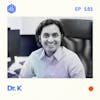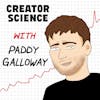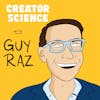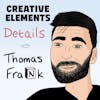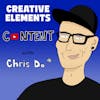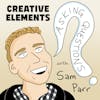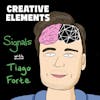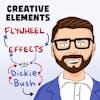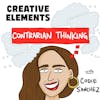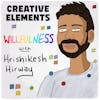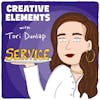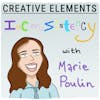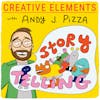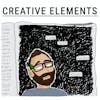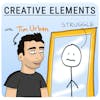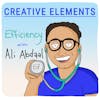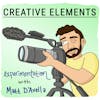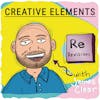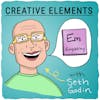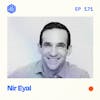
#171: Nir Eyal – Writing books, persuasion vs. coercion, and how to be indistractable
Play EpisodeNir Eyal is the best-selling author of Hooked and Indistractable
Nir Eyal is a writer, consultant, and teacher at the intersection of psychology, technology, and business. He's the author of two best-selling books. Hooked, How to Build Habit Forming Products (2014) and Indistractable, How to Control Your Attention and Choose Your Life (2019).
Previously, Nir cofounded and sold 2 tech companies since 2003 and was dubbed by the MIT Technology Review as "the prophet of habit-forming technology." He previously taught as a lecturer in marketing at the Stanford Graduate School of Business and the Hasso Plattner Institute of Design at Stanford.
In this episode, you’ll learn:
- About Nir's life as an author
- Habits and distractions
- Capturing the attention of an audience
- And how we can better focus our own limited energy and attention
Full transcript and show notes
Nir's Website / LinkedIn / Twitter / Instagram
***
CONNECT
🧰 Get my full gear list (free)
🙏 Make a guest or mailbag request
📝 Check out our curated Playlists
***
SPONSORS
💼 View all sponsors and offers
***
SAY THANKS
💜 Leave a review on Apple Podcasts
Learn more about your ad choices. Visit megaphone.fm/adchoices
Nir Eyal [00:00:00]:
When you are publishing on someone else's platform, you are borrowing their habit. You are renting that habit from them, because at the end of the day, it's Google or Facebook or YouTube or TikTok that actually owns the consumer habit.
Jay Clouse [00:00:30]:
Hello, my friend. Welcome back to another episode of Creator Science. Today, I am talking with Nir Eyal. I've been following Nir's work for a long time going all the way back to 2014 when I was building a software company. Nir cofounded and sold 2 tech companies himself since 2003 and was dubbed by the MIT Technology Review as the prophet of habit forming technology. Today, Nir is a writer, consultant, and teacher at the intersection of psychology, technology, and business. He previously taught as a lecturer in marketing at the Stanford Graduate School of Business and the Hasso Plattner Institute of Design at Stanford.
Nir Eyal [00:01:07]:
I would say I'm a behavioral designer, which means that I help Companies build the kind of products and services that improve people's lives through healthy habits.
Jay Clouse [00:01:15]:
Now if you heard Nir's name before, chances are you've heard of 1 of his 2 best selling books. The first was Hooked, How to Build Habit Forming Products, published in 2014, and Indistractable, How to Control Your Attention and Choose Your Life, published in 2019.
Nir Eyal [00:01:30]:
My first book Hooked is about how we can use technology to build good habits in people's lives, and it's been used in pretty much every conceivable industry from health care to fintech, to education, anywhere where we need repeat user engagement, where, there's a product that would improve the user's life if they use the product. So there's so many products out there that that would be great. Right? That could help people eat right and exercise, learn a new language, connect with their loved ones, if they actually use the product. And so what I specialize in is helping product teams design the kind of products that people use because they want to, not because they have to. And then in the course of writing Hooked, I also got to see the other side. Right? That, if Hooked is about how to build good habits, I also want to explore how do you break the bad habits, and especially the bad habits around distraction. And so that's what my 2nd book is about. Indistractable is about how do we make sure that we do what we say we're going to do.
Nir Eyal [00:02:23]:
How do we Stop getting distracted.
Jay Clouse [00:02:25]:
I wanted to talk to Nir about his life as an author, but also dig into habits and distraction. As content creators, our businesses are built on capturing attention for better or for worse, and I knew Near would have a unique perspective on that. Plus, we dig into how we can better focus our own limited energy and attention using the frameworks he created for his 2nd book, Indistractable. I'd love to hear what you think about this episode. You can find me on Twitter or Instagram at jklaus. A lot of people have been sharing these episodes recently and tagging me, which I absolutely love. I see every one of them, and Goes such a long way in growing the show, so thank you. But now let's talk to Nir about why he wrote his first book, Hooked.
Nir Eyal [00:03:10]:
Essentially, I've been blogging for many years, And, I kept getting questions from my blog readers of, hey. I've I I I read your blog post, but I wanna share this with my team, and, you know, like, how how do I get this all together? Can you can you put together somehow. And so I just put together a PDF real quick and, worked together with my friend, Ryan Hoover, to kind of, You know, take 2 years of blog writing and putting it putting it into a structure, and then, I self published it on on KDP, and then it started taking off. It started getting all these 5 star reviews, and it was only then that I got a call from my agent, well, the woman who's now my agent, saying, Hey, you should really, you know, consider professionally publishing So we took it down and republished it with Penguin, which is part of Random House. Yeah, it's been off to the races.
Jay Clouse [00:03:53]:
Did you think of yourself as an author when you first Kind of made the the digital version of this. Was that where you were aiming your career towards?
Nir Eyal [00:04:00]:
So I I always enjoyed writing. I was a journalism co major in school. I I didn't think I would do it as a profession. Frankly, I didn't know you could do this as a profession. And the only reason I started writing Hooked was because I needed it. So I had started a couple tech companies. Well, the first one was in solar, then that one was acquired, and then I started another company, co founded another company with a few friends while in business school, And when that company was was wound down and sold, we I kind of had some time on my hand and I had this hypothesis that Whatever I was gonna do next, I wanted to start another company, but I knew it had to be something that was habit forming. Why did I think it had to be habit forming? Because I could See that the interface that we were using technology through was changing.
Nir Eyal [00:04:41]:
That as we went from desktops to big screens on our desktop, to laptop screens, which were a little bit smaller, to mobile screens, to wearable devices, and now to auditory devices. You know, the when we think about the Amazon Alexa or whatever, the the auditory device that we just Ask for. There is no visual interface anymore. So the interface the visual interface shrunk until it disappeared. And so I could see that trend happening, And this was back in 2012, and I knew that as that was going to happen, habits would become increasingly important, because there's just less Visual real estate to trigger people to action. Right? So when you have a big honking screen on your desk, there's lots of places to trigger people with calls to action. But as the interface shrank, it would become increasingly important to have habits. So if you think about your your phone, right, if if you're not on the home screen of someone's device, If they don't remember to use you, your app might as well not even exist.
Nir Eyal [00:05:37]:
So I knew it had to be absolutely critical, it had to be imperative to build a habit forming product, or might as well not even build 1 for this type of interface. And so I looked around and tried to find books on how to build habit forming products, and I couldn't find any, So I decided to write my own book for myself thinking, okay, I'm just gonna write this for myself. It's gonna inform what I'm gonna do next. So I just started blogging about it, And, in the process of blogging about it, I accrued kind of a a little audience, and one of my audience members was a former professor of mine from Stanford, Baba Shiv, and, he said, Hey, I really like your model. I love your research. What if we taught a class together? So he invited me to teach a class with him at the Stanford Graduate School of Business, and then I did that for a few years, and then later I got asked to teach a class at the Hassle Planner Institute of Design at Stanford, the d. School. And so it was just kind of one thing led to another, and what I thought would be a temporary thing to start another business, another tech startup ended up being what I do, and it turns out I I love it.
Nir Eyal [00:06:31]:
I really enjoy the the the writing and speaking and teaching and consulting, and so that kind of became my my next gig.
Jay Clouse [00:06:37]:
In this creator world, people identify in their own minds as different things. And, actually, I was talking to probably a mutual friend of ours, James Clear, about This recently where he said, you know, I've always thought of myself as an entrepreneur, and the book just happens to be the products that I create. You know? And I was I was wondering if you kind of identified with that lens With a background in start ups.
Nir Eyal [00:06:56]:
It's a little bit different. I think I think I think it's very hard to write a book as a product. I mean, there is definitely some aspect of that, of making sure you're writing, some people want something that people want to read, and in that respect it's very much like making a product that people want to use. I guess it's a little bit different different for me, because it's too difficult for me to worry about whether, people are going to love the book. It's too much. It's too stressful. And frankly, it's hard
Jay Clouse [00:07:25]:
to be stressed about it.
Nir Eyal [00:07:27]:
Yeah, because it really stifles, I feel like, what what I enjoy about writing. And so the only model I figured out that can help me consistently write is to write what I need. So I'm not one of these authors that writes what they know. I write what I want to know, and in the process of writing what I want to know, I become a world leading expert on the topic. How amazing is that? Right? I get paid to learn. I can't think of a better profession. So, you know, I I don't see the what's the point of writing another book about a topic that's already been written. Why would I do that? So when I have a problem in my life, I talk to my wife about it.
Nir Eyal [00:08:04]:
I talk to my friends about it. If I still don't get resolution, if I just still don't find the answer I'm looking for, I'll read books about it. And listen, 9 times out of 10, somebody's written a great book about The problem I have, and so I find the the answers in a way to to to that problem that I'm struggling with. Now every once in a while, maybe every once in every 5 years or so, There's a problem that after I read all the books on the topic, still isn't resolved. And this is what happened for me with both of my books. I didn't find a book on how to build habit forming products. I I saw a lot of books, like, you know, what James wrote. James' book came out after, but there were lots of books about habits, around personal habits.
Nir Eyal [00:08:39]:
I didn't find any books about product habits. How do we build habits with the devices, with the services, with the content, with whatever commercial Products we are using, I didn't see any book about that specifically, so I wanted to write it. When it came to indistractable, I found lots of books about distraction, and focus, and productivity, but they all kinda had the same tone, which was stop using technology. Right? And it's a personal willpower issue. And it didn't work for me. I got rid of my technology, and
Jay Clouse [00:09:08]:
I was still distracted.
Nir Eyal [00:09:09]:
So I knew that wasn't the right angle, so I really wanted to write books that, that that scratch my own itch and solve my own problems. And so my mantra when I'm writing is follow my curiosity, and, that's only that's the only way I can keep myself interested, frankly. And if I if I write formally, and if I write, oh, I want to write a book like that author or or in this topic, then People people can detect that it's just recycled stuff, and so they they want they want novelty, and I want novelty. I want to read something new that that I haven't I haven't read before. And so to keep up that novelty and to keep my own interest in writing, I have to follow my curiosity.
Jay Clouse [00:09:45]:
Yeah. So something you mentioned a 2nd ago, you said you you kinda saw the other side of habit forming technology while you're writing Hooked. It started to make you think about Indistractable be really curious to know at what point did you kind of commit to this idea of Indistractable being the next Book, was it while you're writing Hooked? Was it some time afterwards? How closely together were those ideas?
Nir Eyal [00:10:07]:
Oh, it was, quite a time afterwards, because while I was writing Hooked, I wasn't all that busy. Right? I just had a little blog with a few 1,000 blog subscribers, And, I was doing consulting here and there, but but I wasn't terribly busy. But then once Hook came out, I got really busy And I got lots of requests for speaking engagements and consulting work and, all kinds of of other projects, and it took me away from doing the thing that I really love to do, and that made me successful in the 1st place, which was the writing. And so it was kind of, in a way, a curse of success. It's a high class problem, but a problem nonetheless. And so I want to figure out how do I stay on track? How can I continue to write despite having all these distractions in my life, let alone the toll it was taking on my family? Right? I was with my daughter and I would be on my phone. I would say I was going to exercise, but I wouldn't, And so I really wanted to crack the the the code, if there was such a code, around how can I just follow through? I knew the things I needed to do, And yet somehow, at the end of the day, I didn't do what I say I would. And so that's what Indistractable is all about, and it's totally autobiographical.
Nir Eyal [00:11:12]:
Right? This is a problem that I struggle with and I needed to fix, And I'm happy to say that after, you know, writing this book for 5 years, took me 5 years to write the book, because I kept getting distracted while I was writing it, until I figured out these these solutions, these answers. It took me a long time to find, you know, I wanted not only solutions that worked for me, right? You read a lot of self help books out there and personal advice books, they're like, Oh, this worked for me, so it's going to work for you. Not good enough. To me, I needed a higher bar. Not only did I wanted techniques that actually worked for me, but we're backed by good scientific evidence. Right? I wanted peer reviewed studies. In the book, there are 30 pages of citations to peer reviewed studies. I wanted that kind of scientific backing to make sure that, hey, wow, this isn't a fluke.
Nir Eyal [00:11:55]:
Not only does it work for me, it's going to work for for everyone, statistically, because these techniques have all been very well studied.
Jay Clouse [00:12:02]:
I want to come back to this point you just made around personal integrity here in a second, because that's really important to me also. But real quick, when you when you had this idea, you had this itch, you realize you wanted to be indestructible, but you're, you know, you're you're touring Hooked still. Was there an incentive to make Hooked Volume 2? You know, like, the the next version of this or the updated version of this. Did you have to face any headwinds of saying, actually, I kind of want to make the other side of the coin of Hooked versus, like, continuing down that same path?
Nir Eyal [00:12:33]:
The idea was definitely floated around, like, let's just keep doing more of the same. But I again, you know, my mantra is to follow my curiosity, and I kind of felt like, You know, the model covered you know, there's always room for improvement. You could always go deeper in the topic, you know, maybe showing more examples. But, fundamentally, I I wanted Hook to be a stand alone model. And so the hook model these 4 parts of the hook model, the hardest part about writing Hooked and coming up with this hook model was not what to put in it, it was what to exclude. That's always the hardest part, I think, of of the kind of books I work on, is how do you remove the stuff that's interesting, but not as helpful. And so once I did that and I felt, okay, I chipped away, I chipped away, I chipped away. Okay.
Nir Eyal [00:13:11]:
Here's here's what's left. It's kind of how they say, you know, Michelangelo, said that he would, You know, chip away the marble, until the statue that was there all along was revealed. And so that's kind of what my job was. Okay, here's all the research that you don't need to know, or all the research that was really Done poorly. That's that's not even true. There's a lot of academic research out there that's awful. And so once I had that model, I, you know, I didn't I didn't Feel like it needed more elaboration, maybe more examples, but, you know, that you can get, I give away for free on my website, if you want more case studies.
Jay Clouse [00:13:42]:
As I was preparing for this, I kept coming to this, like, really hard to articulate thought. So this is gonna be kind of a jumble, but I'm gonna try to get it out there because I think it's an interesting conversation. In Hooked, you know, you talk about how a lot of these companies, social media companies, a lot of creators listening to this, They built a lot of their business on, you know, Instagram, Facebook, Twitter, LinkedIn now to some degree. These platforms Engineer their product to be sort of habit forming. Right? Mhmm. But the product within the product It's actually the content that creators make. So are are the creators making habit inducing work? Should we be? This is what I'm wrestling with as a creator on these platforms is, am I part of the problem or am I Additive to the to the whole ecosystem.
Nir Eyal [00:14:37]:
But what's the problem?
Jay Clouse [00:14:38]:
Well, the problem being that, let's say, People feel like, you know, I'm spending too much time on TikTok, and part of that is me putting out just banger videos on TikTok, You know, so people are watching it. They're enjoying it in the moment, but their their post reflection is often, I regret that time that I spent. How should we feel about that?
Nir Eyal [00:15:02]:
Yeah. Well, if they are regretting the time they spent, I would argue that's not a long term sustainable model, either with your content and probably with these platforms, and I think we we see that already. Right? Like, when I wrote Hooked, Facebook was the big bad, you know, the behemoth. And now, frankly, I don't know anyone under 35 that uses Facebook anymore. Facebook proper. I know Facebook owns WhatsApp, and they know use Instagram, but Facebook proper, like the, you know, the the Facebook blue is what they call it. Sure. I don't know anybody use that anymore, because it's kind of become a dumpster fire of politics and advertising, and it's just not, it's not good anymore.
Nir Eyal [00:15:40]:
And so what is everybody using now? Now they're using Instagram. They're using Because what happened, when a product is something that doesn't improve people's lives, when it doesn't make them feel better off, when they the critical word that you used is regret. People aren't stupid. Right? For the vast majority of people, they either stop using the product, they use it less, or they find an alternative. And so that's what we we've seen with media in general. Right? People have gone from radio to, newspapers to television to, cable news to, social media, we keep evolving what media platforms we enjoy because they provide us different aspects of what we're looking for. So that's not necessarily a bad thing. I think the harm is there's a couple different different potential harms.
Nir Eyal [00:16:30]:
The biggest harm I mean, of course, there's, you know, misinformation, disinformation, and polarization, all kinds of that stuff, but let's put that aside for now. We're not talking about the content itself, because I think, You know, by and large, these platforms have gotten much, much better at moderating the content. I mean, they employ tens of thousands of people, if not hundreds of thousands of people collectively, to monitor the content. So you don't really see that much of a problem in terms of of of bad content as much as you used to anymore. Of course, it's going to it's going to be there, but Seems like they're doing a pretty good job lately, since there was so much attention on the content itself. So let's put that aside for a second. When you talk about the the conversation around how people spend their time, we have to ask ourselves, what's being spent? Right? What's being spent is their time and attention. And so I think, you know, your responsibility, as a content creator, is to make something that you're proud of, to make something that you think is time well spent.
Nir Eyal [00:17:19]:
Now, that's not necessarily a requirement. I mean, there's a lot of, you know, if you want to be, if you want to waste people's time on snack food, you know, snack food content that doesn't really improve their lives, you can do that. There's not I'm not saying that that's, not a viable business strategy. But I think it's worth looking at yourself in the mirror and asking, is that how I want to spend my limited time on earth? So in Hooked, I have this 4 part framework that asks you basically, the section is titled The Morality of Manipulation. Because any Form of design, whether it's graphic design, interior design, video design, any type of design is a form of manipulation. All design, interior design is a form of manipulation, because you are manipulating people's emotions and behaviors. And that's not necessarily a bad thing. It depends what type of manipulation it is.
Nir Eyal [00:18:08]:
So I think there's 2 kinds of manipulation. You have what's called persuasion and you have coercion. Persuasion is helping people do things that they themselves want to do, but for lack of good product design, don't do. So I think that's perfectly ethical. So if an app or if content helps you exercise, helps you, eat right, helps you connect with loved ones, educates you, does something that helps you do something you yourself want to do, but currently, it's too difficult. Like, you know, the type of content that you find, by and large, on YouTube is fantastic. There's I've learned so much on YouTube, and so because much of that content is bringing me information that I otherwise would not have access to. Now, the opposite of persuasion is coercion.
Nir Eyal [00:18:46]:
Coercion is when we get people to do things they did not want to do, things that primarily lead to regret. That's that critical word, regret. That when I look back on it, I say, oh, that was was foolish. That that was not a good use of my time. I did not like that. That was I regret spending time with the product. And I would argue that not only is that ethically bad, right, to to coerce people. It's also bad business, because over time, as we just mentioned earlier, people are not stupid.
Nir Eyal [00:19:11]:
They will Stop interacting with you. They will stop reading your content. They will stop, they will look for alternatives to your platform, if the content is coercive. Right? If it doesn't give them what they what they're looking for, if it doesn't if it's not aligned with their goals, if it's coercive rather than persuasive.
Jay Clouse [00:19:28]:
After a quick break, Nir gives us a simple 2 part framework for identifying whether we are being coercive or persuasive, And later, we talk about how we can be more indestructible. So don't go anywhere. We'll be right back. And now, back to my conversation with Nir.
Nir Eyal [00:19:46]:
So there's a 2 part test, I give product makers and content creators can use the same test to ask themselves if they're on the right ethical path. And the 2 part test is this. Number 1, Is what I'm working on materially improving people's lives? That's the first question. Is what I'm working on materially improving people's lives? And that's not a question for you to judge other people or other people to judge you. It's a way for you to ask yourself, hey, am I spending my limited time on earth in a way that I would feel good about? Is this materially improving people's lives? Now, this can be An app, this could be content, this could be a video, it could be a book, whatever it is that you're working on. Look at yourself in the mirror and honestly ask yourself, is what I'm working on materially improving people's lives? That's question number one. Okay. Question number 2 is, I want you to break the first rule of drug dealing.
Nir Eyal [00:20:35]:
What's The first rule of drug dealing. The 1st rule of drug dealing is never get high on your own supply. So I want you to get high on your own supply. So the second question is, am I the user? Am I the user? So if you answer in the affirmative to these 2 questions, am I materially improving people's lives and I am the user, I say go for it. I say use these behavioral design tactics, build the kind of product and service or content that you can feel good about ethically. Also, from a business perspective, you're in a really good because you're making something that people really want. And if there are deleterious consequences to that, guess what? You're going to be the 1st person to know about it. Right? So I think that's a good ethical bar.
Nir Eyal [00:21:15]:
Now, might there be unintended ethical consequences? Of course. I guarantee you Zuckerberg, when he created Facebook, had no idea about all the Unintended consequences. Right? Paul Virilio, the philosopher, said, when you invent the ship, you invent the shipwreck. So there will be unintended consequences to any massively used Technological innovation. Of course, there will be, and there always has been. Right? So the the the but the idea is if you can If you can predict that there are negative consequences and you are the user, you're gonna know about it first. And so I think that puts you in a good ethical place. Now, You could say, hey, I'm not working on something that materially improves my lot my life, or I'm not the user.
Nir Eyal [00:21:52]:
Again, I'm not saying that's that you're not gonna make money, but that's not the question. The question is, Can I sleep well at night? Am I on the right ethical side? So that 2 part test, if you pass, you're what I call a facilitator. And I think I think that's a good ethical place to be.
Jay Clouse [00:22:07]:
Yeah, I like that reframe, especially the case of is this something that I'm proud of? You know, because a lot of times the game within the game that we're playing is Okay. The the rules of the platforms are changing, or what's finding traction now is changing. And so now I have to package my ideas differently so that they have a better chance to succeed. And sometimes, it feels like we are being reactionary to what the platform wants, but really it's audience viewing behavior. And it feels like, this is taking away some of my creative choice now, and it it feels like we're being coerced by the platforms to make content that we aren't necessarily. It wouldn't be our 1st choice, in some cases. Right. And that's frustrating.
Nir Eyal [00:22:48]:
Yeah. I mean, we do need to realize that that if you, and this is what I'd like to encourage content creators to To think about is when you are publishing on someone else's platform, you are borrowing their habit. You are renting that habit from them. So you are only 1 piece, you're 1 cog in that machine, because at the end of the day, it's Google or Facebook or or YouTube, or TikTok, that actually owns the consumer habit. And any time you are at the mercy of their algorithm, you don't have much power. Right? Because they can throttle you any way they want. That's that's the way the system works. Okay? As opposed to when you own your audience.
Nir Eyal [00:23:29]:
So the difference between publishing stuff on YouTube versus having an email list, right, or a Substack, where you have a direct connection, you know their emails, and so you can send out content. Now, they not open that content, but if they did, it's a one it's a direct relationship. And so I I always advise folks in the content creation Space, whether you're an author, or making videos, or whatever you're making, find ways to own the audience, not rent the audience. You're gonna have much more power and a much more sustainable business model when you own your audience, and much more creative freedom, I should say, too. You don't have to abide by
Jay Clouse [00:24:03]:
Yeah.
Nir Eyal [00:24:03]:
You know, What the algorithm is looking for, you can make the kind of content you want and what your audience wants.
Jay Clouse [00:24:09]:
I haven't had that lens before, the lens of the habit is I'm bored or I'm lonely or I'm trying to avoid something else. I'm opening Twitter. It's not I am these things. So I wanna see what Jay is tweeting. And so you're you're really the beneficiary of the platform owning the habit. That's such an interesting one that I haven't thought of before.
Nir Eyal [00:24:28]:
Yeah, absolutely. I mean, and this is what, you know, I always wanted a product that gave me, like, when Twitter was bigger than it is, you know, a bigger deal than it was And before, and there were some really fantastic people who were on Twitter spouting all kinds of wonderful ideas, and I remember thinking, like, why hasn't anybody built a product that just gives me a digest of what my favorite people on Twitter have have tweeted. And then I realized, well, the reason why is because Twitter doesn't want that. Twitter would shut that down. What they want is for you to come to Twitter and keep scrolling and scrolling and scrolling. That's how they make money. That's how every media company monetizes. I don't care if it's CNN or Fox News, The New York Times, The Wall Street Journal.
Nir Eyal [00:25:04]:
Old media, new media, it doesn't matter, legacy media, they all make money by monetizing your eyeballs. We all know that. So Twitter doesn't want you to have the information and and Leave and go about your day. They want to keep you on as long as possible. Well, what that means is that we, as content creators, are always at their mercy, when it comes to their algorithmic feed. Whereas when you own that relationship, right, when you have and to date, the only way I know how to do that is through email, in some way, shape or form. When you own e mails, that to me is money in the bank. So I literally have a dollar amount that I think about for every e mail I get, and I don't sell anything.
Nir Eyal [00:25:40]:
Right? Other than my my book for, what is it, $20? There's nothing like, I don't really sell anything to people, but I know, and you don't have to buy anything to subscribe to my my newsletter. I don't charge for my newsletter, but I know that over time, hey, you know, maybe you will buy the book, or maybe, you know, 1 out of a 1000 people might hire me for a talk or something. So when I give that value to people through my newsletter, I build that one to 1 relationship without any intermediary, to to moderate that relationship.
Jay Clouse [00:26:07]:
Really getting to the weeds here, and I love that. You know, I'm a big fan of email as well. That's an owned audience relationship, because it's decentralized. There's no There's no third party incentive for the email gods to bring you subscribers. Right? So knowing everything that you know about capturing attention. How do you think about bringing new subscribers into your email world?
Nir Eyal [00:26:31]:
Okay. So this is the hardest part. This is the hardest part. So the trade off we make, the Faustian bargain that we make with the platforms, is that They bring us the audience, but you can't keep the audience. It's still their audience, and they can take it away whenever they want. Alright? They can demonetize you. They can, they they can throttle you. They there's all kinds of things that they can do whether you like it or not because you never actually only audience.
Nir Eyal [00:26:55]:
So when you see you have a bunch of YouTube subscribers, you can't you can't reach out to them. Like, if if you owe if you have a bunch of emails if you have a bunch of YouTube subscribers and you publish a book, All you can do is make a video about it.
Jay Clouse [00:27:07]:
It's like, I hope they watch their subscribe feed.
Nir Eyal [00:27:10]:
Exactly. Exactly. And that's it. But when you send someone emails, You know, you know, you have open rates don't change. You're going to have that consistent open rate in every single email, and and there's a basic psychology about around why it's called variable rewards or intermittent reinforcement. You can't see what's in the email until you open the email. And and open rates on email, still, you know, someone Chose to subscribe. Spam is a different story.
Nir Eyal [00:27:32]:
Never spam, never buy lists. That's a bad idea. But if someone has authentically said, hey, I really like Nir's writing, And I want to subscribe to to see what he's gonna write next. That's a very authentic relationship. We we we love that. And frankly, today, if you have a big enough list mean, this was James Clear. You mentioned our our mutual friend, James Clear. This was the genius of what he did.
Nir Eyal [00:27:52]:
You know, he walked into a publisher, and he said, I have a book idea. They said, And you said, oh, by the way, I have a 1,000,000 person email list. They said, okay, here, sign. If you have a 1,000,000 person email list, I mean, it's it's It's, your book still has to be good, but, boy, is it easier to get the ball rolling when it comes to, making a New York Times list or or something like that. Just because you have a massive audience, just the law of percentages, you're going to sell a certain fraction of those people. But, you know, a million email list is worth orders of magnitude more than a 1000000 subscribers on YouTube. Right? Way way way more, because you're the the you're much more likely to induce action with email. Now how do you grow that email list? Okay.
Nir Eyal [00:28:34]:
So it used to be, I would say what is it now, 2023? So I would say, like, maybe 10, 15 years ago, it was shooting fish in a barrel. It was super easy. All you had to do was to write content that people were searching for, and you would rank for it. And if you could find that trend before other people could, you were gonna rank on Google, and you were gonna get, you know, a ton of traffic. That's become much, much harder. I mean, this this is what what James did. Right? Like
Jay Clouse [00:29:01]:
Yeah. He talked about the form. Also?
Nir Eyal [00:29:03]:
What's oh, okay. Maybe. Yeah. Yeah. Yeah. So so with James, it was intermittent fasting. He had the canonical article on intermittent fasting when very few people were talking about intermittent fasting. And then it went crazy, and he got a ton of of traffic.
Nir Eyal [00:29:16]:
And he had to keep up consistent content that was really high quality. You have you have to make good quality content. That's that's the the the the the bare minimum. Everybody has to make, you know, even to to rank, but you also had to predict what would be the the the big trend, and it was a lot easier than I think today, to rank highly. How how do you do it today? The only thing that's left, I think, is just writing good stuff, and then having having good calls to action. I think I see a lot of authors out there who write great content with a really crappy call to action. Right? Like their website is designed in such a way that even if I wanted to subscribe, even if I wanted to hear more from you in the future, it's not a very good it's not a well designed user interface to get me to, to to subscribe. Now, Substack has kind of changed the game in that they have designed their page to be very clean, very clear, very, you know, call to action that's right up where it should be.
Nir Eyal [00:30:13]:
And so they they you know, if someone will come to your page, High much higher chance that they will convert versus if you, you know, built a website from scratch. The problem is that very few sub stack pages will rank for SEO, and so you kind of give up 1 or the other. They just don't seem somehow, I don't know if Google is doing it, or maybe it just hasn't been around long enough, or maybe the timing was off. But if you look at search results for, you know, high volume terms, it's you don't see many Substack pages up there. So if you ask, Okay, how do I do it? You write good shit. You make content that that people want to share with their coworkers. That's That's probably been the best growth mechanism that I've seen to date, is you write an article that people can't help but sharing with their colleagues. Maybe they'll post it to Hacker News.
Nir Eyal [00:31:02]:
Hacker News is still, that's like one of the If you can get on the front pages of Hacker News, you're going to get a lot of traffic to your website, and and, of that a certain number will subscribe, but the best is, especially if you're writing, you know, for my audience, these are these are people who are knowledge workers. So if I can write something that somebody says, Oh, wow. Hell, yeah. That's that's a really good point. I got to send that to Marjorie and to Jennifer and to Bill, and it's very organic. I don't think there's any more, like, magic bullets of, Oh, write this article, and it's going to be the article that that Google decides to write, especially now, just just not to go too far on this point. G p ChatGPT changes everything now, right? Because Yeah. Search is going to be weird.
Nir Eyal [00:31:39]:
You could write a roundup post, and actually, it would rank because it would be like, Oh, here's the definitive article on motivation, and then You cite, you know, here's, like almost a book about motivation is going to rank. Well, today, that like that would take me seconds with ChatGPT because that's what ChatGPT does. Now I think this is this is going to create a flood of boring content. Right? I think ChatChpT is really good for regurgitating what's already out there. That's what it is. It's a large language model. It's not artificial intelligence. It's a large language model.
Nir Eyal [00:32:10]:
What does a large language model do? It predicts the next word that should come in a phrase. That's all it does. Just what's what what should come next. So it's really good at writing an article on summarize, you know, build me the latest, build me an article on, the ultimate guide to such and such. Really good at doing that, because looking at the web, and it's seeing what's already been written, and it's regurgitating it for you in seconds. But those articles are super boring, because there's nothing new about them. Right? There's nothing exciting. There's no variable reward.
Nir Eyal [00:32:41]:
And so for great content, you always need mystery, and so you can't rely on that alone.
Jay Clouse [00:32:48]:
Someone actually made the point to me today. They predicted that creators who Don't embrace video are actually more at risk with the chat g p t world because it's harder to differentiate. Like, it's Still gonna be easier to tell authentically. Nir sat down and said this and did this because it's on video. Now, of course, we're also gonna get to deep fake technology and Audio technology, where, like, even that could be spoofed in the near future, I'm sure.
Nir Eyal [00:33:16]:
Yeah. You know, supply and demand, when there's a lot of supply of something, it becomes less and less valuable. We don't have a ChatChpT for video yet, and so I think you're absolutely right. I think video is going to become increasingly important. I think also, if you think about it, in many ways, Video is a better medium to convey certain types of information. It's just higher bandwidth. Right? Like if I was going to write out a scene, It would take a lot of time to convey, okay, the temperature was this, and the lighting was this, and here's what was, you know, here's where we are, and here's what I'm feeling. Whereas in a video, I can show that in in a few seconds.
Nir Eyal [00:33:49]:
Of course, the trouble with video is that it's hard to produce. I would love to make more video, but it it takes a very special skill set. So, yeah, I I would definitely do more of it if I knew how. So I I I think you're right. It will become more valuable.
Jay Clouse [00:34:02]:
After 1 last break, Nir and I talk about distraction, and he tells me that the opposite of distraction isn't focus. This really surprised me, so stick around, and we'll be right back. And now, please enjoy the rest of my conversation with Nir Eyal.
Nir Eyal [00:34:17]:
When we talk about distraction, one of the first questions I like to ask to see if people really understand what is distraction is to ask them what is the opposite of distraction. And so most people, if you ask people, what is the opposite of distraction, most people will tell you the opposite of distraction is focus. Right? I don't want to be distracted. I want to be focused. But that's not exactly right, that if you look at the origin of the word, the opposite of distraction is not focus. The opposite of distraction is traction. Right? Obviously, traction, distraction. But most I didn't realize that until I really looked at the the etymology of the term.
Nir Eyal [00:34:47]:
So both words come from the same Latin root, triharae, which means to pull, and they both end in the same six letters, a c t I o n, that spells action. So traction is any action that pulls you towards what you say you're going to do, things that you're doing with intent, things that move you closer to your values and help you become the kind of person you want to become. Those are acts of traction. The opposite, dis Traction is any action that moves you away from what you plan to do, away from your goals, away from becoming the kind of person you want to become. So this is really important because I would argue that the difference between traction and distraction is intent. So Dorothy Parker said it perfectly. She said, the time you plan to waste is not wasted time. So if what you want to do is, watch videos on YouTube or scroll TikTok or watch Netflix, play a video game, Doesn't matter.
Nir Eyal [00:35:34]:
Fine. Do it. Don't be guilty about it. I think we we are way too quick to moralize and medicalize these behaviors. There's Nothing wrong with with consuming content. It's fine. It enhances our life. It's fun.
Nir Eyal [00:35:46]:
But do it on your schedule and according to your values, not someone else's. So anything you plan for in advance with intent is traction. Okay? Don't feel guilty about it. Now, conversely, Anything that is not what you plan to do is distraction, even if it's a work related task. So this is one thing that used to get me all the time. I would sit down my desk And I'd say, okay, now, I'm going to work without any distraction. I'm totally going to be focused here. I'm not going to get distracted.
Nir Eyal [00:36:14]:
I'm going to get started On this big task, I'm going to write. I'm going to, you know, whatever it is I need to do, that that task I've been procrastinating on. But first, let me check some e mail. Right? Let me just scroll that Slack channel real quick. Right? Just to catch up on what's going on. Let me do some easy stuff on my to do list just to get going, just to get some momentum. And what I didn't realize is that that is the most dangerous form of distraction, the distraction that tricks you into prioritizing the urgent and the easy work at the expense of the hard and important work that moves your life and career forward. So just because something is a work related task, doesn't mean it's not a distraction.
Nir Eyal [00:36:48]:
I would argue that's the most Dangerous form of distraction because you don't even realize you're getting distracted. So that's that's a fundamental difference. What is traction? Traction is anything that you say, in advance, you're going to do with your time and attention. Distraction is anything else. So there's no moral judgment. Right? You can get distracted from playing video games, because there's no moral judgment about video games being good, bad or ugly. Like, what's the difference between playing video games or watching football? There's no difference.
Jay Clouse [00:37:14]:
Right. Right.
Nir Eyal [00:37:15]:
But why is 1 melting your brain, and the other is just fine? Right? There's no difference. So if you plan for it in advance, it's traction. Anything else It's distraction.
Jay Clouse [00:37:24]:
What I've also heard you say that I hadn't heard before, you can't label something a distraction if you don't know what it distracted you from. That's right. This this idea of intent, which as a content creator, you know, we are on these platforms all the time as a creator and as a Student of the platform, it's really easy to never actually declare what is my intent with this time right now. What am I going to get out of it? Yeah. I see a lot of creators mismanage their time. They're not getting what they know the outcome they want to be is, which is produced work, but they don't Necessarily declare intent with their time as often as I think they could. So could you talk about that a little bit and how we can use this to better manage our time?
Nir Eyal [00:38:07]:
Totally. Totally. So, so we have traction. We have distraction. The the 2 missing pieces of the model are triggers. So triggers are things that call us to action, that tell us what to do next, and there's 2 kinds of triggers. We have external triggers, so you can think about an arrow from the bottom pushing you towards traction or distraction. That represents external triggers.
Nir Eyal [00:38:26]:
External triggers are the things in our outside environment, the pings, the dings, the rings, anything in our outside environment that leads us towards traction or distraction. Now they're not all necessarily bad. Right? If you have an alarm clock that says, hey, you gotta wake up at 6:30, that would be an external trigger moving you towards Friction, because that's what you intended to do. But if you're with your kid and you're having some quality time together, and now your phone buzzes or boops or beeps, and now you're paying attention to your phone as opposed to being with your child. Well, now that external trigger has led you towards distraction. So we've all felt that in one form or another. Turns out those external triggers only account for 10% of our distractions, 10%. What's the other 90%? The other 90%, even though people tend to blame their devices, those external triggers for their distraction, 90% of distractions don't come from outside of us, but rather studies find they begin from within.
Nir Eyal [00:39:17]:
These are called internal triggers. So we've got traction, we've got distraction, we've got external triggers and internal triggers. Internal triggers are uncomfortable Internal states, these are uncomfortable emotions that lead us to find distraction. So boredom, Insecurity, fatigue, stress, anxiety. This is the source of 90% of our distractions. So when you find yourself Mindlessly scrolling on on YouTube or wherever, and you're saying you're, oh, I'm doing research, right? But meanwhile, it's gone way over time for what you allotted for it. What's likely happening is that you are looking to escape an uncomfortable emotional state. I don't feel like doing work right now.
Nir Eyal [00:39:59]:
I, I'm not I'm not feeling motivated. I'm feeling stressed. Right? These are feelings. And if you don't master these feelings, if you don't master these internal triggers, they will become your master. And this is a cold, hard truth that I think you don't see In any other time management productivity literature out there, or at least not in the popular press, you see it definitely in the psychology literature when you look at the studies, is that if you don't focus on strategies to deal with the internal triggers, you will always find distraction. Okay. Whether it's too much news, too much booze, too much football, too much Facebook, you're going to find distraction somewhere, if you don't understand the internal trigger that is prompting you to escape that discomfort. So that's where we have to start.
Nir Eyal [00:40:43]:
Step number 1 to becoming indestructible is mastering internal triggers. And then step number 2 is making time for traction. So this is where we actually have to make a schedule. Right? How many of us use this stupid antiquated to do list technique, which is making things worse? I'm telling you, I hate to do lists because of the fact that they don't have any constraints, as opposed to a timebox calendar is a much smarter way to go. Then the 3rd step is to hack back the external triggers. And then finally, the last step is to prevent distraction with pacts. And it's these 4 strategies done in concert. This is how anybody can become indistractable.
Jay Clouse [00:41:18]:
Well, let's let's take one step back. I don't know if we're gonna have time to get to the packs. So if you're intrigued by this, please pick up the book Indistractable. It's fantastic. I wanna I wanna talk and draw this back to content creators a little bit because Yeah. I understand a lot of the emotions that I feel on a day to day basis of, like, boredom, anger, loneliness, sadness. What I didn't understand until hearing some of your other interviews, the act of creating something new, which is what creators are doing all the time. That is hard, and I have emotions about that that I hadn't quite labeled, you know, just the difficulty of I have time blocks on my calendar for 2 hours a morning for writing time.
Jay Clouse [00:41:58]:
I sit down. I say this is my writing time, and suddenly, I'm answering email, and I hadn't thought about that emotional state. So can you talk about that and how that's that's normal and in the emotions we're having around that might not be a A bad thing?
Nir Eyal [00:42:13]:
Totally, totally. And I think we are, you know, because things are so good from a relative historical perspective, We don't have to experience anywhere near as much discomfort as our ancestors did. Right? When people think about, like, Things are tough these days. And yeah, the world is crazy because the world's always been crazy, right? But when we think about like what our ancestors had to deal with, right? Their children weren't surviving past, you know, a few years. They were constantly dealing with infections. They were hungry. They were migrating, they were at the whims of nature, like, they, you know, the human psyche and body is built to weather discomfort, but only if it's exposed to those difficult conditions. So what happens to us in our life is we sit at our cute little desks and we have our nice little cup of coffee, and everything is brought to us, and everything is easy, and everything is simple, which is amazing, like, thank God, we get to live in this age where, hey, you know, this technology is connecting us through thousands of miles.
Nir Eyal [00:43:14]:
Right? You're, you're in the States. I'm in Singapore. We're talking live through this technology for free from the comfort of our homes. This is amazing. Like, if you would have told people a 100 years ago, their their brains would have Yeah, like their brains would have literally exploded. Right? Like they would not be able to process what we're doing right now every single day, but the price of all that progress is that frankly, we're weak. Okay. I'll admit it.
Nir Eyal [00:43:37]:
I'm weak. Compared to what my grandparents had to go through, I'm weak. Right? Like, I I expect a certain level of comfort, and that's great. Right? It's not my fault. I didn't choose to be born when I was born, but The the result of being born in this age is that when discomfort rears its ugly head, many of us, myself included until I started this line of research, we don't know what to do. We look for escape. And so what the brain does, what the brain has always done, is look for the easiest way to take us out of a state of discomfort. It's always looking for what's called homeostasis.
Nir Eyal [00:44:12]:
It always wants to regulate itself to a certain level of of comfort. So when it's hungry, go get something to eat. When you're tired, take a nap. When you know, whatever it is. When you're lonely, Seek someone to entertain you. You you constantly do this to yourself. Now, what most people do, people who are distracted, myself included, before I did this line of research, Was we seek the easiest solution. So when I'm, uncertain about my business, go check email.
Nir Eyal [00:44:37]:
Email will tell me what to do. Right? When I'm bored, go go check something out, you know, go look for a video on YouTube. When I'm lonely, scroll my friend's Facebook. Whatever it might be, The brain will always tell you to do what you have done before that has satisfied that discomfort. So what we have to do is to have a set of tools ready to go, knowing that our brain and I hear, by the way, it's it's interesting. People will make up the craziest excuses. People say, Well, you know, I'm creative. I need to go with my gut.
Nir Eyal [00:45:06]:
When I get an intuition and I need to do this or that, I gotta go with that. And that's exactly what amateurs say. Professionals don't say that. Professionals, you know, Stephen Pressfield talks about this in his books, as well, about the resistance, that there's this voice in your head that you think is your ally, and it's not. It's your enemy. It's the voice that tells you, you know, you should probably take a little break, or you need another cup of coffee, or, you should take a nap, or, you know, why don't you scroll some videos, do some research? That voice in your head that you think is you, it's not you, It's your enemy. It's the resistance telling you to get distracted versus what professionals do. They put their butt in the chair and they do the goddamn work, and they can only do that by focusing on the task at hand.
Nir Eyal [00:45:47]:
Now, one of the big pitfalls is that people measure themselves by how much they finish. Of course, you do, right? Aren't you supposed to measure yourself by, hey, how much did I get done? That is a fool's errand. And this is, by the way, one of the reasons that to do lists are so counterproductive because when you measure yourself by how many cute little boxes you check off, You have no feedback mechanism to tell you how much time things took. Right? As a knowledge worker, Our two forms of input is attention and time. That's it. Our time and attention, that's our only input in order to create the output. With someone who's not a knowledge worker, let's say you're a baker. Okay? If you go to a baker and you say, hey, I it's my kid's birthday party.
Nir Eyal [00:46:33]:
I'm going to need 2 dozen cupcakes. Okay. Well, the baker's going to go away, and he's going to think to himself, okay, I need sugar, I need flour, I need butter. You need input to create output. Right?
Jay Clouse [00:46:42]:
Mhmm.
Nir Eyal [00:46:42]:
So for us, for knowledge workers, our only 2 forms of input is time and attention, but we don't budget The time and attention to get the output. We think it's magically going to appear. And so, we make to do lists full of output. Finish editing. Write the Script. Do this. Do this. Do this.
Nir Eyal [00:46:58]:
Do this. All the output. And we never sit down and think, what's the input? And the only way to register that input It's to timebox. It's to plan in advance how long you're gonna work on a task without distraction. That is our new metric of success. It's not how many things that I finish. You have very little control of how many things you finish. What you do have control over It's how much time and attention you devoted to the task at hand.
Nir Eyal [00:47:24]:
So what I what this book is all about, or at least this section of the book, this strategy around making time for traction, is you measure yourself by planning time for whatever it is you want to do. It could be time with your family. It could be time working on a big project. Whatever it is, you book that time. So I'm going to work on this project for 30 minutes without distraction. Okay? And then at the end of those 30 minutes, you're going to say, well, how far along did I get when I worked without distraction? And now, you have a feedback mechanism, where you could say, okay, I was working on this script and I did about 10% of it. Right? And so I'm gonna need 10 more time blocks like that to finish the whole thing. Whereas someone who uses a to do list method, they work on it for 5 minutes and then they say, Oh, let me just check email real quick, and then let me just do this one thing, and, Oh, I need a cup Coffee and I'm gonna do this, and they have no idea how long things actually take them, which leads us to the planning fallacy.
Nir Eyal [00:48:11]:
The planning fallacy says that on average, a task takes 3 times longer to finish than people estimate. And the reason this happens is because people don't use this time boxing technique that I talk about in the book, and it's not a technique I invented. It's been around for a very long time. It's the most studied Time management technique in psychology literature has thousands of peer reviewed studies. It's about making time for traction. If there's something you need to do, You make time for it in a timebox and then you you stick to that timebox and you don't measure yourself by how much you finish, you measure yourself by your ability to work without distraction. And here's the kicker, People who do that, people who simply work based on that method of working without distraction, not did they finish, but did they work without distraction, Actually finish more. They actually get more done than the to do list devotees.
Jay Clouse [00:48:56]:
Well, to bring this home, I love this analogy you gave Of clearing the brush as part of the creative process, how we go into this. And it's hard Because by definition, we're often doing what has never been done before. And the actual mental work of Figuring that problem out is work, and it's hard, and it's gonna create some level of discomfort In you. Yeah. But that discomfort can drive you to clear the brush, is the way that you put it, and I really like that.
Nir Eyal [00:49:28]:
Yeah. What we find is with people who are high performers, They feel the same internal triggers the rest of us do. They also feel lonely and bored and indecisive. Like, you think of people who are top of their game at every field, They all feel the same way. The difference is that high performers use that discomfort like rocket fuel to drive them towards traction, Whereas low performers, whenever they feel those internal triggers, they try and escape it with distraction. That's the cardinal difference. The difference between these people who are top of their game and everyone is they know how to master their internal triggers. They use them to their advantage rather than trying to escape them.
Jay Clouse [00:50:09]:
I hope you now feel better equipped to prevent distractions in your own day to day life. If you wanna learn more about Nir, you can visit his website atnearandfar.com. That's n I r a n d far.com. Links to that as well as his books will be in the show notes. Thanks to Niyir for being on the show. Thank you to Nathan Todd Hunter for mixing this episode. Thanks to Emily Klaus for making the artwork for this episode and Brian Skiel for creating our music. I'd love to hear what you think about this episode.
Jay Clouse [00:50:37]:
You can tag me on Twitter or Instagram at jklaus. Let me know what you think. And if really wanna say thank you. Please leave a review on Apple Podcasts or Spotify. It goes so far. Seriously, hear me when I say this.
Most Popular Episodes
New to the show? Check out some of our most popular episodes.







